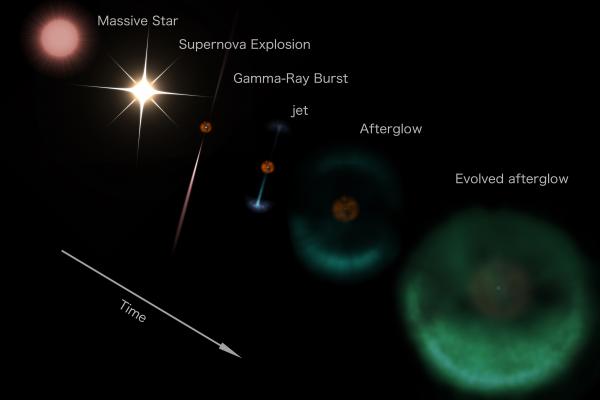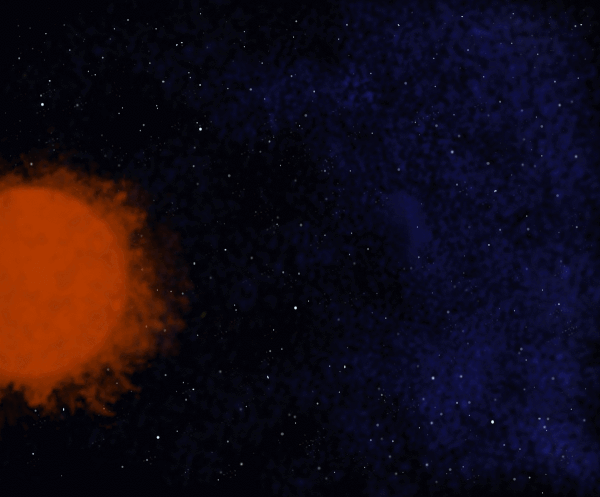
Astronomers have found the ‘smoking gun’ of an ‘orphan’ gamma-ray burst afterglow. Gamma-ray bursts are brief, intense flashes of gamma-rays that are difficult to detect. They are believed to be linked to cataclysmic events such as the collapse of a massive star, or the collision and merger of two neutron stars. Evidence of an ‘orphan’ gamma-ray burst afterglow provides astronomers with more possibilities to study, and ultimately understand, such phenomena.
When the biggest stars in the Universe reach the end of their lives, they collapse due to their own gravity and produce explosions known as supernovae. In some cases, they also emit a gamma-ray burst, which contains a huge amount of energy: a flash of a few seconds can hold as much energy as the Sun would produce during its entire life. This makes these events detectable across very long distances.
Astronomers believe that these gamma-rays are produced by a very fast jet of material expelled by the star during its collapse. The gamma-rays are preferentially emitted forward, and can therefore be detected only if the jet points directly towards the Earth. After the gamma-rays, on the other hand, the jet decelerates and expands in the interstellar gas, producing a longer-lasting, fainter afterglow which may be visible also when the jet points away from the Earth. If the afterglow is detected, but the gamma-ray burst is not, the afterglow is said to be ‘orphan’.
Until very recently, there have been no solid detections of orphan gamma-ray burst afterglows. Recently, a team of astronomers found a source, FIRST J1419+3940, located 300 million light years away. FIRST J1419+3940 is visible at radio wavelengths, but the emission has been fading for the last 30 years. The observed decay is consistent with what is expected during the evolution of a gamma-ray burst afterglow – yet the gamma-ray burst itself had never been seen.
This object was particularly interesting as its environment (that is, the galaxy where it took place) also resembled the environment where the only fast radio burst studied in detail so far is located. Fast radio bursts are extragalactic bursts of radio emission that last for just a few milliseconds and it is still unclear where they originate from. “The team thought that FIRST J1419+3940 could be another place where these fast radio bursts can be produced, maybe unveiling a connection between gamma-ray bursts and fast radio bursts”, explained Kenzie Nimmo from the University of Amsterdam.
After discovering the object in 2018 a team of astronomers led by Benito Marcote (JIVE) conducted a fast response observation (known as a Target of Opportunity) to look at the emission in real time. They used the astronomy technique Very Long Baseline Interferometry to combine radio astronomy antennas from the European VLBI Network, across Europe, Asia, and South Africa. The team studied the object in detail at a high resolution – equating to being able to read a newspaper from a distance of 40 km.
At this level of detail the team were able to measure the size of the object. They noted that it corresponded to a cloud with a size of five light years across, which was ejected after the original explosion and that has been traveling all this time (around 30 years) at an average of 10% the speed of light. Such speeds could only have been produced by an extreme explosion, like those seen during gamma-ray bursts.
“If the jet were pointing towards the Earth, this would have been seen as an extremely bright and powerful gamma-ray burst.” explained Om Salafia, from the National Institute for Astrophysics (INAF), Italy. “No such burst has been observed at the time of the explosion, but this is not unexpected: the probability that the jet was pointing towards the Earth is very low. For these reasons, we believe that this afterglow is actually orphan”.
FIRST J1419+3940 is thus the first strong evidence that astronomers have of an orphan gamma-ray burst afterglow.
Future detailed observations of this object will help to understand more about this ‘smoking gun’ of a gamma-ray burst. In particular, how the material ejected in these events propagates and interacts with the surrounding medium and whether there is a fundamental link between fast radio bursts and gamma-ray bursts, or if an orphan gamma-ray burst could actually be responsible for producing fast radio bursts.
Contact
Gina Maffey - Science Communication Officer
The Joint Institute for VLBI ERIC (JIVE)
Email: maffey@jive.eu
Phone: +31 521 596 543
Benito Marcote - Corresponding Author
The Joint Institute for VLBI ERIC (JIVE)
Email: marcote@jive.eu
Phone: +31 521 596 508
Additional Information
A total of 12 antennas from the European VLBI Network (EVN) were involved in this observation: Jodrell Bank Mark2 (UK), Westerbork single-dish (The Netherlands), Effelsberg (Germany), Medicina (Italy), Onsala (Sweden), Tianma (China), Toruń (Poland), Hartebeesthoek (South Africa), Sardinia (Italy), and three antennas from e-MERLIN (Cambridge, Defford, and Knockin) in UK.
The EVN is an interferometric array of radio telescopes spread throughout Europe, Asia, South Africa and the Americas that conducts unique, high-resolution, radio astronomical observations of cosmic radio sources. Established in 1980, the EVN has grown into the most sensitive VLBI array in the world, including over 20 individual telescopes, among them some of the world's largest and most sensitive radio telescopes. The EVN is administered by the European Consortium for VLBI, which includes a total of 15 institutes, including the Joint Institute for VLBI ERIC (JIVE).
e-MERLIN is a National Facility operated by the University of Manchester at Jodrell Bank Observatory on behalf of STFC.
The Joint Institute for VLBI ERIC is an international institute based in the Netherlands that provides support, conducts leading research and forwards technical development in the field of radio astronomy. Its primary mission is to operate and develop a powerful supercomputer, known as the correlator, which processes data from the European VLBI Network (EVN) – an array of radio telescopes located across the globe.
JIVE is funded by six member countries: the Netherlands, France, Latvia, Spain, Sweden and the United Kingdom; it is also supported by four participating research institutes: the National Astronomical Observatories of China, the Max Planck Institute for Radio Astronomy, the Italian National Institute of Astrophysics and the National Research Foundation. JIVE is hosted at the offices of the Netherlands Institute for Radio Astronomy (ASTRON) in the Netherlands.
Image credits
Artist's impression of the time evolution of the observed event: from the original massive star, and the explosion during its death that produced a hidden gamma-ray burst, to the afterglow that was finally observed. Credit: Benito Marcote (JIVE).
Artist's animation of the orphan gamma-ray burst afterglow (massive star, explosion, gamma-ray burst, travelling jet bullet, expanding afterglow). Credit: Katharina Immer (JIVE).
Paper
ApJL: Marcote et al. (2019, vol. 876, L14)
https://iopscience.iop.org/article/10.3847/2041-8213/ab1aad/meta
https://ui.adsabs.harvard.edu/abs/2019ApJ...876L..14M/abstract

